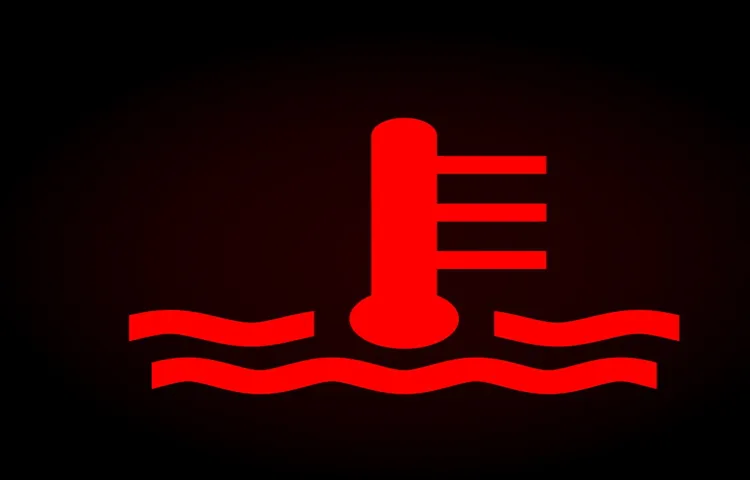Have you ever opened the hood of your car and wondered what all those symbols mean? Each symbol is there to alert you of something important about your car’s performance and safety. One of the most common symbols you may see is the coolant symbol. But what does it look like, and why is it so important to keep an eye on it? In this blog, we’ll take a closer look at the coolant symbol, what it means, and why you should never ignore it.
So buckle up, and let’s dive in!
Table of Contents
Understanding the Importance of Coolant
If you’re driving and notice that the coolant symbol is illuminated on your car’s dashboard, it’s crucial to address it immediately. The coolant symbol looks like a thermometer submerged in liquid, typically colored blue or green. Coolant is a liquid that circulates through your car’s engine to prevent it from overheating.
Without the proper amount of coolant, your engine could malfunction, leading to costly repairs. Therefore, it’s crucial to ensure that your car’s coolant levels are maintained. Keeping an eye on the coolant symbol and checking your coolant levels regularly can prevent significant engine issues from occurring.
Additionally, if you notice any leaks or strange smells coming from your vehicle, seek automotive assistance immediately. Remember, keeping your car maintained will save you money in the long run and extend the life of your vehicle.
What is coolant?
Coolant is a type of fluid that helps regulate the temperature of a vehicle’s engine under various conditions. It’s also known as antifreeze since it helps prevent the engine from freezing in low temperatures. Understanding the importance of coolant is crucial in keeping your vehicle’s engine running smoothly.
When the engine overheats, it can cause severe damage that can lead to costly repairs or even replacement. Coolant helps to disperse the heat generated by the engine to prevent overheating, providing protection for the engine’s critical components. Furthermore, coolant also helps to prevent corrosion, which can cause damage to the engine, resulting in reduced performance and lifespan.
To maintain the optimal performance of your vehicle, it’s essential to ensure that your coolant is regularly checked and replaced as recommended by your vehicle’s manufacturer. Neglecting to maintain your coolant can result in costly repairs, poor engine performance, and reduced lifespan.

Why is coolant important for your car?
Coolant is an essential component in keeping your car’s engine functioning correctly. It helps to regulate the temperature of your engine and prevent it from overheating. When your engine is running, it generates a lot of heat, so it’s essential to have something in place to manage this heat.
Coolant is responsible for absorbing and dissipating this heat, so it doesn’t cause any damage to your engine. Using the right type of coolant in your car is also essential. Different types of coolant are designed to work with specific engines and have different properties, such as anti-corrosion and anti-freezing.
Neglecting to keep your coolant maintained can lead to severe engine damage and even result in your car breaking down. Therefore, it’s critical to check it frequently and make sure it’s at the correct level. In conclusion, keeping your coolant maintained and using the right type is essential for ensuring your car remains in top condition and avoiding any potential engine issues.
Locating the Coolant Symbol
When it comes to understanding car symbols, locating the coolant symbol can be a bit tricky. This important symbol looks like a thermometer floating in waves of liquid. It’s typically found on the dashboard of your vehicle and indicates your engine temperature and whether your engine is overheating.
Coolant, also known as antifreeze, helps regulate your engine’s temperature and prevent it from overheating. It’s important to keep an eye on this symbol and keep up with regular maintenance on your car’s cooling system to prevent damage to your engine. So, if you’re wondering what the coolant symbol looks like, keep an eye out for a thermometer in liquid waves – it could be the key to preventing a major engine problem down the line.
Where to Find the Coolant Symbol on Your Car Dashboard
If you’re wondering where to find the coolant symbol on your car dashboard, don’t worry, you’re not alone! The coolant symbol can look quite different across manufacturers, but usually consists of a thermometer submerged in water or the letters “C” and “H”. It’s important to locate this symbol as it indicates whether your engine is running at the proper temperature and whether the coolant levels are sufficient. Typically, the coolant symbol can be found near the temperature gauge or within the instrument cluster.
Some cars may also have a separate warning light that illuminates if the engine temperature rises too high or if there is a problem with the coolant system. If you’re still having difficulty locating the coolant symbol, check the owner’s manual or consult a certified mechanic for assistance.
What Does the Coolant Symbol Look Like?
When your car’s engine starts to overheat, it’s essential to check the coolant level to prevent any further damage. But, what does the coolant symbol look like? Well, it’s usually an image of a thermometer rising out of liquid, indicating the temperature of the coolant. You can typically locate this symbol on the dashboard, near the temperature gauge or warning lights.
The symbol may also include text such as “coolant” or “engine.” It’s important to remember that if your car’s engine is overheating, you should turn off the engine and wait for it to cool down before attempting to add more coolant. In some cases, overheating can lead to serious engine damage, so it’s always best to seek professional assistance if you’re unsure.
By knowing what the coolant symbol looks like and understanding its importance, you can help keep your engine running optimally and avoid costly repairs.
Conclusion
In conclusion, the coolant symbol is like a tiny reminder that even machines need a refreshing break from time to time. It’s a quirky little icon that signals the need for some liquid love to keep our engines running smoothly. So, the next time you see that little thermometer rising or that warning light flashing, remember to check your coolant levels and give your trusty vehicle the care it deserves.
“
Why You Need to Know What the Coolant Symbol Looks Like
Knowing where to locate the coolant symbol on your vehicle is crucial, especially in times of emergency. The coolant system regulates the temperature of your engine and prevents overheating. However, it is not uncommon for engines to overheat, which can result in costly repairs.
By knowing the coolant symbol, you can quickly locate the coolant reservoir and add more coolant if necessary. This will help keep your engine running smoothly and prevent any further damage. It is important to note that the coolant symbol may vary based on the make and model of your car.
Therefore, it is essential to consult your vehicle’s owner’s manual to locate the symbol. Most vehicles will have the coolant symbol on the coolant reservoir cap, which is typically yellow or green in color and shaped like a small water droplet. Don’t let engine overheating catch you out of surprises – make sure to locate the coolant symbol on your vehicle today!
FAQs
1. What is coolant and why is it important for a car’s engine? Coolant is a mixture of water and antifreeze that helps regulate the temperature of a car’s engine. If the engine overheats, it can cause serious damage, so it’s important to keep the coolant levels topped off. 2. What does the coolant symbol look like on a car dashboard? The coolant symbol looks like a thermometer submerged in liquid, with wavy lines above it indicating heat. 3. How often should I check and replace my car’s coolant? It’s recommended to check your coolant levels every time you get an oil change, and to replace the coolant every 2-3 years or 30,000-50,000 miles. 4. What happens if my car runs low on coolant? If your car runs low on coolant, it can cause the engine to overheat, which can lead to serious damage such as a blown head gasket or warped engine parts. 5. Can I use water instead of coolant in my car’s radiator? While water can be used as a temporary solution, it’s not recommended to use it long-term as it doesn’t have the same antifreeze and corrosion inhibitors as coolant. 6. How do I know if there’s a coolant leak in my car? Signs of a coolant leak can include a sweet smell coming from the engine or radiator, visible puddles of coolant underneath the car, or an overheated engine. 7. How do I properly dispose of old coolant? Old coolant should never be poured down the drain or thrown in the trash. It should be taken to a hazardous waste facility for proper disposal.



